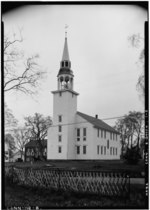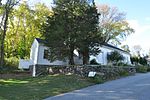Putnam Farm
Brooklyn, ConnecticutBuildings and structures in Windham County, ConnecticutFarms on the National Register of Historic Places in ConnecticutHouses completed in 1750Houses in Windham County, Connecticut ... and 3 more
National Register of Historic Places in Windham County, ConnecticutUse American English from October 2021Use mdy dates from October 2021

The Putnam Farm is a historic farm on Spaulding Road in Brooklyn, Connecticut. The property, now just 9 acres (3.6 ha) of agricultural land with a house (built about 1750) on it, was the centerpiece of a vast landholding in the mid-18th century by Major General Israel Putnam, a major colonial-era military figure who saw action in both the French and Indian War and in the American Revolutionary War. The property was listed on the National Register of Historic Places in 1982.
Excerpt from the Wikipedia article Putnam Farm (License: CC BY-SA 3.0, Authors, Images).Putnam Farm
Spaulding Road,
Geographical coordinates (GPS) Address Nearby Places Show on map
Geographical coordinates (GPS)
| Latitude | Longitude |
|---|---|
| N 41.823333333333 ° | E -71.950833333333 ° |
Address
Spaulding Road 85
06234
Connecticut, United States
Open on Google Maps









